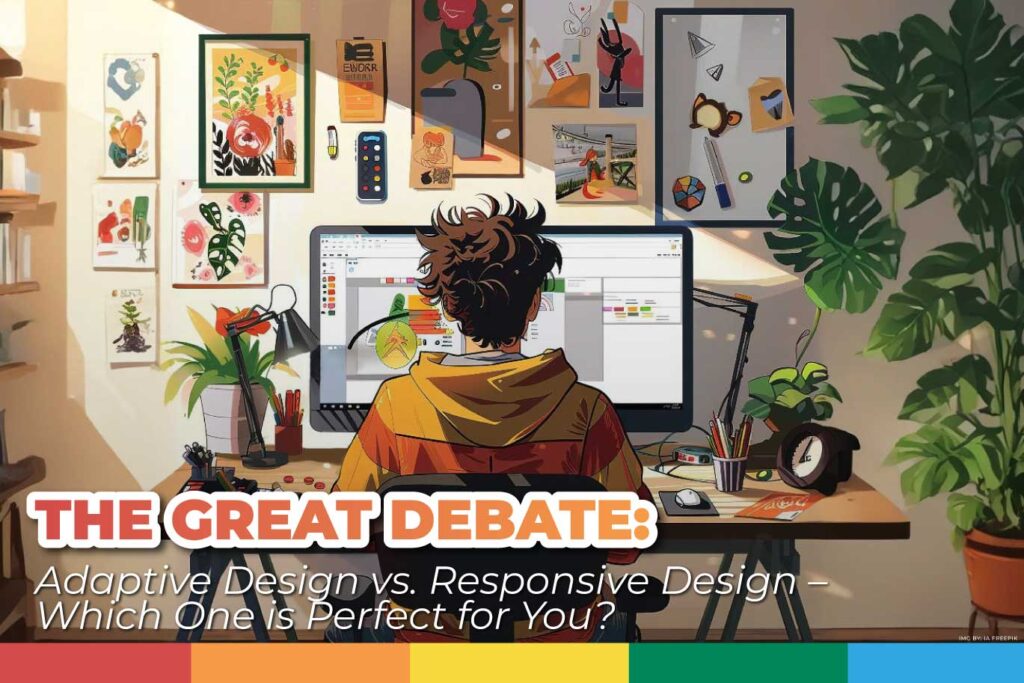Ah, web design… that ancient art (well, not that ancient) of making websites look good no matter where or how you look at them.
But when it comes to choosing between adaptive and responsive design, it’s like deciding between pepperoni pizza and Margherita! Both are delicious, but they have different ingredients.
First, let’s talk a bit about each one. Because you need to know what you’re getting into before choosing, right? Or did you go on a first date with your ex without knowing anything about them? You didn’t, did you? Now, buckle up and join me on this journey to discover which of these approaches is your tech soulmate.
What is Responsive Design?
Imagine your website is a yoga expert. Responsive design is that magical flexibility that allows content to stretch, shrink, and adjust depending on the device you are using.
It’s like having an outfit that adapts to any occasion: from a formal event on a laptop to a casual afternoon on a smartphone.
- Pro: A responsive design looks great everywhere, whether someone is viewing it on a giant TV or a smartwatch (who even does that?).
- Con: That flexibility requires more initial work since you need solid coding and a design that doesn’t break.
Responsive design mainly relies on media queries, a CSS component that adapts the layout based on screen size.
Additional Advantages:
- Simplified Maintenance: You only need to manage one unified design instead of multiple versions.
- SEO-Friendly: Google loves responsive design because it enhances user experience and mobile navigation.
- Future-Proof: Since the design is flexible, it can easily adapt to new devices and screen sizes that haven’t even been invented yet.
Deeper Limitations:
Though it sounds ideal, there are challenges. Images and videos may need extra optimization to avoid long loading times. Also, some highly specific designs might lose important details when adjusting automatically.
What is Adaptive Design?
Now, adaptive design is like having a custom-tailored three-piece suit. Instead of stretching, it creates different versions of your website specifically for different devices.
If you’re on a phone, you see a version optimized for phones. If you’re on a desktop, you get the “fancy” version.
- Pro: It’s like a restaurant with a special menu for every taste; each device gets the best possible experience.
- Con: It takes more time (and budget) because you’re creating multiple versions of the same design.
Adaptive design typically relies on predefined layouts for specific screen widths (e.g., mobile, tablet, and desktop). When a user accesses the site, the device is detected, and the appropriate version is displayed.
Key Advantages:
- Total Control: Each version can be fine-tuned down to the last detail.
- Personalized Experience: It provides a tailored experience based on the device’s characteristics (e.g., better touch navigation on mobile).
- Lighter Load: Users receive only the elements they need for their device, which can reduce loading times.
Additional Disadvantages:
This approach can be more expensive and complex to develop since it requires creating and maintaining multiple versions of one design.
Which One is Perfect for You?
Here’s where things get serious (especially for your wallet). If you have a website that needs to cater to a wide variety of devices and prefer a “one-size-fits-all” solution, then responsive design might be your best choice.
But if you want to offer unique and customized experiences for key devices, adaptive design could be the king of your digital kingdom. (RIP your budget, though.)
What to Consider:
- What’s your budget and timeline? Adaptive design requires a bigger initial investment, while responsive design can be faster and more cost-effective.
- Do you know your audience well? If your audience is mostly mobile users, adaptive design can provide a superior experience. But if you expect diverse traffic, responsive design is more practical.
- How dynamic is your content? If your site needs frequent updates, responsive design might be easier to manage in the long run.
At the end of the day, both approaches are like loyal friends who want the best for you.
If web design were a reality show, responsive and adaptive design would probably tie in the season finale, each with their own army of fans shouting “Team Responsive!” or “Team Adaptive!”
The key is to understand your needs and choose the champion that will help you win the hearts (and screens) of your audience.
Need help to figure out which one is perfect for you? Contact us!







